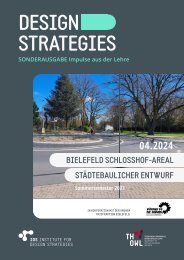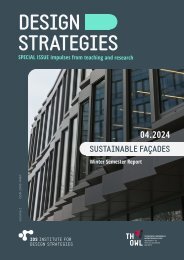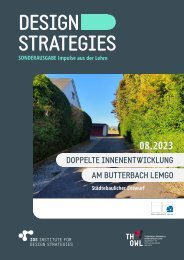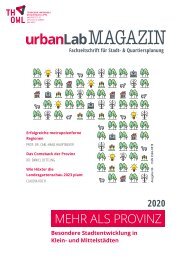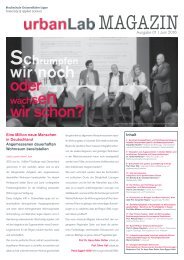urbanLab Magazin 2021 - Transformation
Sie wollen auch ein ePaper? Erhöhen Sie die Reichweite Ihrer Titel.
YUMPU macht aus Druck-PDFs automatisch weboptimierte ePaper, die Google liebt.
Fig. 6: Render represents façade interaction with people inside the building<br />
reaction delay time. The prototype has<br />
shown the movement of a kinetic mechanism.<br />
This motion illustrates an aesthetic<br />
sequence of one mechanical module.<br />
However, a simulation of a whole<br />
kinetic mechanic module is shown on<br />
the Rhino-Grasshopper simulation.<br />
With this model, a concept of interacting<br />
with human kinetic façade has<br />
been demonstrated.<br />
CONCLUSION<br />
This thesis project is an attempt to bring<br />
more attention to the dynamic relation<br />
of humans and façade. As a result, a<br />
second skin facade with an interactive<br />
kinetic system solution has been developed.<br />
This system can react to people's<br />
movements and create an attraction<br />
effect by using both: a sonic sensor<br />
for interactive control and a pre-programmed<br />
script. Kinetic modules can<br />
create a visual effect of a fast-changing<br />
façade from transparent to opaque.<br />
To reach the desired interaction and positive<br />
effect on human perception two<br />
main aspects of kinetic interactive façade<br />
has to be considered: Technological<br />
and Interaction aspect. The function of<br />
a human-interactive kinetic façade can<br />
be oriented to entertainment and advertisement.<br />
It has the potential to engage<br />
the public, as a communication device<br />
for marketing purposes of different<br />
brands. In the design of an interactive<br />
kinetic façade, capital costs can be high,<br />
but they can be recovered from advertising<br />
revenue when used strategically. -<br />
References:<br />
Achten H. 2011: Degrees of Interaction -Towards a Classification.<br />
In Respecting Fragile Places: 29th eCAADe Conference Proceedings.<br />
Ljubljana, Slovenia: University of Ljubljana. p.568-569<br />
Ayyappan K., Kumari M. 2018: A review on the application of<br />
kinetic architecture in building facades. International Research Journal<br />
of Engineering and Technology Vol. 5, no. 8, p. 7<br />
Cuayáhuitl H., Otterlo M., Dethlefs M. 2013: Machine learning<br />
for in interactive systems and robots: a brief introduction. MLIS ‘13<br />
Proceedings of the 2nd Workshop on Machine Learning for Interactive<br />
Systems: Bridging the Gap between Perception, Action and Communication,<br />
p.19-28<br />
Hogan N., Buerger S. 2004: Impedance and interaction control. Robotics<br />
and Automation Handbook, vol. 1. Boca Raton. FL, USA. CRC Press<br />
Weiser M. 1991: The computer of the 21st century. Scientific American,<br />
265(3), p.66–75<br />
Maria Eero<br />
M.Eng. Integrated Design - Facade Design<br />
Originally from Estonia, Maria studied architecture<br />
at the State University of architecture and civil engineering,<br />
Russia (2016). After working for several<br />
years in the architecture field, she pursued an<br />
M.Eng. degree in Facade design (MID) at the Technische<br />
Hochschule Ostwestfalen-Lippe, Germany<br />
(<strong>2021</strong>). There she worked as a scientific researcher<br />
and teaching assistant, and as a team manager of<br />
the FabLab, Detmold. After graduation with the<br />
thesis topic of Interactive kinetic façade, Maria<br />
works as a Facade Engineer and a project researcher<br />
at Dipl.-Ing. Hölscher GmbH, based in Kleve.<br />
140 STUDENT IDEAS






